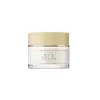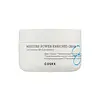What's inside
What's inside
 Key Ingredients
Key Ingredients

 Benefits
Benefits

 Concerns
Concerns

 Ingredients Side-by-side
Ingredients Side-by-side

Oryza Sativa Bran Water
MaskingWater
Skin ConditioningGlycerin
HumectantButylene Glycol
HumectantCetyl Ethylhexanoate
EmollientPentaerythrityl Tetraethylhexanoate
EmollientHydrogenated Polyisobutene
EmollientSynthetic Beeswax
Emulsion StabilisingButyrospermum Parkii Butter
Skin ConditioningPolyglyceryl-3 Methylglucose Distearate
EmulsifyingVinyldimethicone
Pentylene Glycol
Skin Conditioning1,2-Hexanediol
Skin ConditioningBehenyl Alcohol
EmollientGlyceryl Stearate
EmollientAmmonium Acryloyldimethyltaurate/Vp Copolymer
Bisabolol
MaskingCetearyl Olivate
Panthenol
Skin ConditioningSorbitan Olivate
EmulsifyingCaprylyl Glycol
EmollientEthylhexylglycerin
Skin ConditioningXanthan Gum
EmulsifyingAdenosine
Skin ConditioningTrisodium Ethylenediamine Disuccinate
Sodium Hyaluronate
HumectantCeramide NP
Skin ConditioningHydrolyzed Hyaluronic Acid
HumectantOryza Sativa Bran Oil
EmollientTocopherol
AntioxidantPhytosphingosine
Skin ConditioningCaprylic/Capric Triglyceride
MaskingHydrogenated Lecithin
EmulsifyingOryza Sativa Bran Water, Water, Glycerin, Butylene Glycol, Cetyl Ethylhexanoate, Pentaerythrityl Tetraethylhexanoate, Hydrogenated Polyisobutene, Synthetic Beeswax, Butyrospermum Parkii Butter, Polyglyceryl-3 Methylglucose Distearate, Vinyldimethicone, Pentylene Glycol, 1,2-Hexanediol, Behenyl Alcohol, Glyceryl Stearate, Ammonium Acryloyldimethyltaurate/Vp Copolymer, Bisabolol, Cetearyl Olivate, Panthenol, Sorbitan Olivate, Caprylyl Glycol, Ethylhexylglycerin, Xanthan Gum, Adenosine, Trisodium Ethylenediamine Disuccinate, Sodium Hyaluronate, Ceramide NP, Hydrolyzed Hyaluronic Acid, Oryza Sativa Bran Oil, Tocopherol, Phytosphingosine, Caprylic/Capric Triglyceride, Hydrogenated Lecithin
Water
Skin ConditioningGlycerin
HumectantEthylhexyl Stearate
EmollientVinyldimethicone
Pentylene Glycol
Skin ConditioningCocos Nucifera Oil
Masking1,2-Hexanediol
Skin ConditioningCetearyl Alcohol
EmollientPanthenol
Skin ConditioningPolymethylsilsesquioxane
Arachidyl Alcohol
EmollientPropolis Extract
Skin ConditioningHydroxyethyl Acrylate/Sodium Acryloyldimethyl Taurate Copolymer
Emulsion StabilisingPolyglyceryl-6 Stearate
EmollientButylene Glycol
HumectantCarbomer
Emulsion StabilisingBehenyl Alcohol
EmollientGlyceryl Stearate
EmollientTromethamine
BufferingDimethiconol
EmollientCaprylyl Glycol
EmollientArachidyl Glucoside
EmulsifyingHydrogenated Lecithin
EmulsifyingCeramide NP
Skin ConditioningEthylhexylglycerin
Skin ConditioningXanthan Gum
EmulsifyingSucrose Stearate
EmollientPolyglyceryl-6 Behenate
Emulsion StabilisingSodium Polyacrylate Starch
AbsorbentStearic Acid
CleansingPalmitic Acid
EmollientSodium Hyaluronate
HumectantCholesterol
EmollientHyaluronic Acid
HumectantGlycosphingolipids
EmollientHydrolyzed Hyaluronic Acid
HumectantWater, Glycerin, Ethylhexyl Stearate, Vinyldimethicone, Pentylene Glycol, Cocos Nucifera Oil, 1,2-Hexanediol, Cetearyl Alcohol, Panthenol, Polymethylsilsesquioxane, Arachidyl Alcohol, Propolis Extract, Hydroxyethyl Acrylate/Sodium Acryloyldimethyl Taurate Copolymer, Polyglyceryl-6 Stearate, Butylene Glycol, Carbomer, Behenyl Alcohol, Glyceryl Stearate, Tromethamine, Dimethiconol, Caprylyl Glycol, Arachidyl Glucoside, Hydrogenated Lecithin, Ceramide NP, Ethylhexylglycerin, Xanthan Gum, Sucrose Stearate, Polyglyceryl-6 Behenate, Sodium Polyacrylate Starch, Stearic Acid, Palmitic Acid, Sodium Hyaluronate, Cholesterol, Hyaluronic Acid, Glycosphingolipids, Hydrolyzed Hyaluronic Acid
 Reviews
Reviews

Ingredients Explained
These ingredients are found in both products.
Ingredients higher up in an ingredient list are typically present in a larger amount.
1,2-Hexanediol is a synthetic liquid and another multi-functional powerhouse.
It is a:
- Humectant, drawing moisture into the skin
- Emollient, helping to soften skin
- Solvent, dispersing and stabilizing formulas
- Preservative booster, enhancing the antimicrobial activity of other preservatives
Behenyl Alcohol is a type of fatty alcohol (these are different from the drying, solvent alcohols).
Fatty Alcohols have hydrating properties and are most often used as an emollient or to thicken a product. They are usually derived from natural fats and oils; behenyl alcohol is derived from the fats of vegetable oils.
Emollients help keep your skin soft and hydrated by creating a film that traps moisture in.
In 2000, Behenyl Alcohol was approved by the US as medicine to reduce the duration of cold sores.
Learn more about Behenyl AlcoholButylene Glycol (or BG) is used within cosmetic products for a few different reasons:
Overall, Butylene Glycol is a safe and well-rounded ingredient that works well with other ingredients.
Though this ingredient works well with most skin types, some people with sensitive skin may experience a reaction such as allergic rashes, closed comedones, or itchiness.
Learn more about Butylene GlycolCaprylyl Glycol is a humectant and emollient, meaning it attracts and preserves moisture.
It is a common ingredient in many products, especially those designed to hydrate skin. The primary benefits are retaining moisture, skin softening, and promoting a healthy skin barrier.
Though Caprylyl Glycol is an alcohol derived from fatty acids, it is not the kind that can dry out skin.
This ingredient is also used as a preservative to extend the life of products. It has slight antimicrobial properties.
Learn more about Caprylyl GlycolCeramide NP is a type of ceramide and formally known as ceramide 3.
Ceramides are intercellular lipids naturally found in our skin that bonds dead skin cells together to create a barrier. They are known for their ability to hold water and thus are a great ingredient for dry skin.
Ceramides are an important building block for our skin barrier. A stronger barrier helps the skin look more firm and hydrated. By bolstering the skin ceramides act as a barrier against irritating ingredients. This can help with inflammation as well.
If you would like to eat ceramides, sweet potatoes contain a small amount.
Read more about other common types of ceramides here:
Ceramide AP
Ceramide EOP
Ethylhexylglycerin (we can't pronounce this either) is commonly used as a preservative and skin softener. It is derived from glyceryl.
You might see Ethylhexylglycerin often paired with other preservatives such as phenoxyethanol. Ethylhexylglycerin has been found to increase the effectiveness of these other preservatives.
Glycerin is already naturally found in your skin. It helps moisturize and protect your skin.
A study from 2016 found glycerin to be more effective as a humectant than AHAs and hyaluronic acid.
As a humectant, it helps the skin stay hydrated by pulling moisture to your skin. The low molecular weight of glycerin allows it to pull moisture into the deeper layers of your skin.
Hydrated skin improves your skin barrier; Your skin barrier helps protect against irritants and bacteria.
Glycerin has also been found to have antimicrobial and antiviral properties. Due to these properties, glycerin is often used in wound and burn treatments.
In cosmetics, glycerin is usually derived from plants such as soybean or palm. However, it can also be sourced from animals, such as tallow or animal fat.
This ingredient is organic, colorless, odorless, and non-toxic.
Glycerin is the name for this ingredient in American English. British English uses Glycerol/Glycerine.
Learn more about GlycerinGlyceryl Stearate is a mix of glycerin and stearic acid.
It is used to stabilize the mixing of water and oil ingredients. By preventing these ingredients from separating, it can help elongate shelf life. It can also help thicken the product's texture.
As an emollient, it helps soften skin and supports barrier-replenishing ingredients.
In cosmetics, Glyceryl Stearate is often made from vegetable oils or synthetically produced.
This ingredient may not be fungal-acne safe
Fun fact: The human body also creates Glyceryl Stearate naturally.
Learn more about Glyceryl StearateHydrogenated Lecithin is created from the hydrogenation of lecithin (a group of phospholipids). Hydrogenation is a chemical reaction between hydrogen and another element.
This ingredient is an emollient and emulsifier. As an emollient, it helps soften skin by trapping moisture within. As an emulsifier, it prevents oil and water ingredients from separating.
Hydrolyzed Hyaluronic Acid is a form of hyaluronic acid. It is created by the hydrolysis of hyaluronic acid with a high molecular weight. Once created, Hydrolyzed Hyaluronic Acid has a low molecular weight.
Low molecular weight HA has been shown to hydrate and increase elasticity of the skin. Increasing elasticity is also associated with reduction of wrinkle depth.
One study found topical low molecular weight hyaluronic acid may be considered for the treatment of rosacea in the adult population. However, we always recommend speaking with a professional about your skin concerns.
Hyaluronic acids are a humectant. This means they draw moisture from the air. Hyaluronic acids help moisturize, soothe, and protect the skin.
Read more about other common forms of hyaluronic acid:
Learn more about Hydrolyzed Hyaluronic AcidPanthenol is a common ingredient that helps hydrate and soothe the skin. It is found naturally in our skin and hair.
There are two forms of panthenol: D and L.
D-panthenol is also known as dexpanthenol. Most cosmetics use dexpanthenol or a mixture of D and L-panthenol.
Panthenol is famous due to its ability to go deeper into the skin's layers. Using this ingredient has numerous pros (and no cons):
Like hyaluronic acid, panthenol is a humectant. Humectants are able to bind and hold large amounts of water to keep skin hydrated.
This ingredient works well for wound healing. It works by increasing tissue in the wound and helps close open wounds.
Once oxidized, panthenol converts to pantothenic acid. Panthothenic acid is found in all living cells.
This ingredient is also referred to as pro-vitamin B5.
Learn more about PanthenolPentylene glycol is typically used within a product to thicken it. It also adds a smooth, soft, and moisturizing feel to the product. It is naturally found in plants such as sugar beets.
The hydrophilic trait of Pentylene Glycol makes it a humectant. As a humectant, Pentylene Glycol helps draw moisture from the air to your skin. This can help keep your skin hydrated.
This property also makes Pentylene Glycol a great texture enhancer. It can also help thicken or stabilize a product.
Pentylene Glycol also acts as a mild preservative and helps to keep a product microbe-free.
Some people may experience mild eye and skin irritation from Pentylene Glycol. We always recommend speaking with a professional about using this ingredient in your routine.
Pentylene Glycol has a low molecular weight and is part of the 1,2-glycol family.
Learn more about Pentylene GlycolSodium Hyaluronate is hyaluronic acid's salt form. It is commonly derived from the sodium salt of hyaluronic acid.
Like hyaluronic acid, it is great at holding water and acts as a humectant. This makes it a great skin hydrating ingredient.
Sodium Hyaluronate is naturally occurring in our bodies and is mostly found in eye fluid and joints.
These are some other common types of Hyaluronic Acid:
Learn more about Sodium HyaluronateVinyldimethicone is a type of silicone.
Water. It's the most common cosmetic ingredient of all. You'll usually see it at the top of ingredient lists, meaning that it makes up the largest part of the product.
So why is it so popular? Water most often acts as a solvent - this means that it helps dissolve other ingredients into the formulation.
You'll also recognize water as that liquid we all need to stay alive. If you see this, drink a glass of water. Stay hydrated!
Learn more about WaterXanthan gum is used as a stabilizer and thickener within cosmetic products. It helps give products a sticky, thick feeling - preventing them from being too runny.
On the technical side of things, xanthan gum is a polysaccharide - a combination consisting of multiple sugar molecules bonded together.
Xanthan gum is a pretty common and great ingredient. It is a natural, non-toxic, non-irritating ingredient that is also commonly used in food products.
Learn more about Xanthan Gum